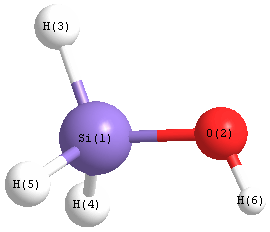Vibrational Frequencies calculated at TPSSh/aug-cc-pVQZ
| Mode Number |
Symmetry |
Frequency
(cm-1) |
Scaled Frequency
(cm-1) |
IR Intensities
(km mol-1) |
Raman Act
(Å4/u) |
Dep P |
Dep U |
|---|
| 1 |
A' |
3858 |
3858 |
78.34 |
87.96 |
0.19 |
0.32 |
| 2 |
A' |
2279 |
2279 |
95.18 |
136.64 |
0.15 |
0.26 |
| 3 |
A' |
2233 |
2233 |
95.08 |
226.56 |
0.05 |
0.10 |
| 4 |
A' |
998 |
998 |
180.02 |
1.59 |
0.75 |
0.86 |
| 5 |
A' |
978 |
978 |
92.96 |
4.66 |
0.73 |
0.84 |
| 6 |
A' |
906 |
906 |
22.72 |
6.81 |
0.31 |
0.47 |
| 7 |
A' |
834 |
834 |
166.89 |
6.53 |
0.21 |
0.35 |
| 8 |
A' |
681 |
681 |
65.39 |
2.43 |
0.61 |
0.76 |
| 9 |
A" |
2226 |
2226 |
165.42 |
60.42 |
0.75 |
0.86 |
| 10 |
A" |
960 |
960 |
69.49 |
5.58 |
0.75 |
0.86 |
| 11 |
A" |
716 |
716 |
59.86 |
4.47 |
0.75 |
0.86 |
| 12 |
A" |
201 |
201 |
94.07 |
0.63 |
0.75 |
0.86 |
Unscaled Zero Point Vibrational Energy (zpe) 8434.6 cm
-1
Scaled (by 1) Zero Point Vibrational Energy (zpe) 8434.6 cm
-1
See section
III.C.1 List or set vibrational scaling factors
to change the scale factors used here.
See section
III.C.2
Calculate a vibrational scaling factor for a given set of molecules
to determine the least squares best scaling factor.
Charges, Dipole, Quadrupole and Polarizability
Charges from optimized geometry at TPSSh/aug-cc-pVQZ
Charges (e)
| Number |
Element |
Mulliken |
CHELPG |
AIM |
ESP |
| 1 |
Si |
0.662 |
|
|
|
| 2 |
O |
-0.597 |
|
|
|
| 3 |
H |
-0.105 |
|
|
|
| 4 |
H |
-0.119 |
|
|
|
| 5 |
H |
-0.119 |
|
|
|
| 6 |
H |
0.279 |
|
|
|
Electric dipole moments
Electric dipole components in Debye
(What's a Debye? See section
VII.A.3)
| |
x |
y |
z |
Total |
| |
-1.268 |
0.050 |
0.000 |
1.269 |
| CHELPG |
|
|
|
|
| AIM |
|
|
|
|
| ESP |
|
|
|
|
Electric Quadrupole moment
Quadrupole components in D Å
Polarizabilities
Components of the polarizability tensor.
Units are
Å
3 (Angstrom cubed)
Change units.
| |
x |
y |
z |
| x |
4.943 |
-0.035 |
0.000 |
| y |
-0.035 |
5.089 |
0.000 |
| z |
0.000 |
0.000 |
4.886 |
<r2> (average value of r
2) Å
2
| <r2> |
39.265 |
| (<r2>)1/2 |
6.266 |
